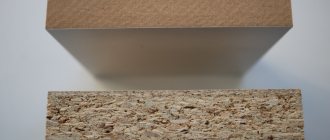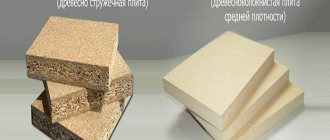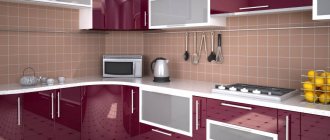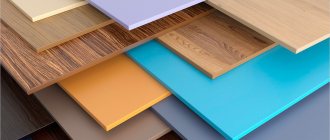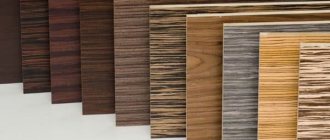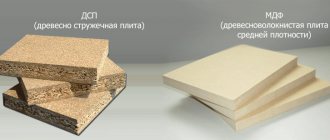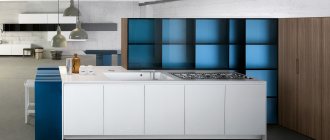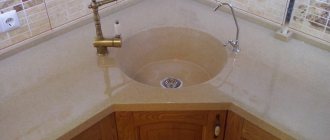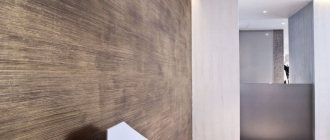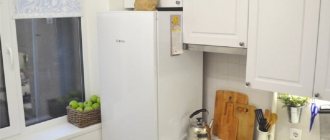Furniture made from chipboard and MDF has long become commonplace. New, easier to process and use, cheaper materials are actively replacing traditional products made from various tree species. And this is not surprising. The performance characteristics of high-quality artificial materials based on sawdust are in no way inferior to solid wood. And in a number of parameters they are even superior.
When choosing furniture for their home or apartment or organization, many buyers ask a logical question: how reliable and durable are these materials, and what are their differences. You often hear that DSAMP and MDF are practically the same thing, made according to common recipes, and there is no point in choosing. Is it so? In order not to make a mistake when choosing furniture, you need to clearly understand the differences between these two materials. What nuances need to be taken into account when purchasing furnishings for certain needs. Let's try to figure it out together with the experts.
What are the differences between laminated chipboard and MDF?
At first glance, indeed, furniture made from chipboard and MDF looks the same. The products look good, almost the same colors and textures are used. Even the shape and style of many models of kitchen, bedroom or living room sets are made according to the same design. Meanwhile, the difference between them is huge: in quality, in operating conditions, and even in price. All the differences are hidden in the depths, behind the attractive facades. They are associated with the peculiarities of production technologies for particle boards and finely dispersed fractions.
The use of metals in kitchen furniture
Metals are also used in kitchen interior design. Most often, alloy stainless steel is used in kitchen sets. This material is used to decorate countertops, facades and walls (work area). Not all doors are often made of stainless steel, but only those that can be exposed to moisture and temperature, i.e. near the sink or stove.
Initially, stainless steel kitchens were used only in catering establishments (restaurants, cafes, etc.), since the metal is environmentally friendly, does not rust, is wear-resistant and easy to clean. No wonder this material is widely used in medicine.
You can place hot objects on stainless steel countertops; they are chemically resistant and do not react to high humidity. But the slightest dirt (fingerprints, drops of water, etc.) is visible on the shiny surface, so it is quite difficult to care for such materials. The solution is to use matte and decorated metal sheets.
In addition to steel, aluminum is also used in kitchens, which is similar to stainless steel, but has a different shade. Sometimes you can find sheet copper, which looks impressive in combination with natural materials (stone, wood, brick).
Disadvantages of laminated chipboard
- Due to the large number of large chips and heterogeneity of the structure, chipboards are prone to chipping of individual particles and the appearance of chips. Products can only be sawed in straight lines. They are not subject to fine milling or laser engraving. Therefore, it is very rare to find beautiful furniture facades made of chipboard, with figured cutouts, 3D relief images, and complex patterns. Mostly even, smooth doors are made from this material, suitable for modern styles.
- If water regularly gets into the joints and seams, the surface in these places swells and bulges into a hump. The product increases its volume up to 30%. The film begins to peel off. Inside the slab, the mass becomes loose, crumbles, and black mold appears. To avoid this, you should choose furniture with laser-cut edges (soldered joints). Such products are more durable. In addition, spilled liquids must be promptly removed by wiping the surface with a soft, clean cloth.
- Due to the low density of the base, the places where the fittings are attached gradually crumble. The fasteners begin to move freely in the socket. Furniture made from chipboard is not intended for frequent assembly and disassembly. It is enough to transport the set 1-2 times to a new place of residence, and it will warp in the most unimaginable way due to completely loose fastenings. To remedy the situation, you can use wood glue or use thicker screws. Or initially purchase products that use not ordinary fasteners, but bolts with wide washers.
- Low-grade types of chipboard negatively affect the health of children, adults, and pets. To produce the cheapest materials, large amounts of resins that emit formaldehyde are used. If new furniture has a specific, chemical smell, it is better to refuse the purchase. Living next to such a time bomb is simply dangerous.
Perhaps the most important disadvantage of laminated chipboard is its short service life. Such furniture lasts on average 5-7 years, subject to the rules of operation.
Plastic – features of use in headsets
Plastic facades are in great demand because they are practical and relatively low cost. This coating is characterized by good moisture resistance and mechanical resistance, and also does not deform from exposure to high temperatures. The choice of material for a kitchen where you often cook should be made in favor of plastic facades, since caring for them will not be difficult.
When choosing between film-coated MDF or plastic on chipboard, you need to understand that film materials are easily scratched and react negatively to elevated temperatures. If for some reason the film comes off, you won’t be able to reattach it and you will have to replace the door.
Advantages of MDF
- Since formaldehyde resins are not used in the production of MDF boards, they are much safer than chipboard. In fact, it is the same wood, with a small content of natural or urea resins, only more uniform and durable. The material is used in the manufacture of children's furniture, cribs and changing tables for newborns, products for children's and medical institutions. By purchasing furniture made from high-quality MDF, the buyer can be completely confident in its safety for health.
- MDF, even in its natural, uncovered form, is not afraid of water. Its dense structure simply does not allow liquids to be quickly absorbed, unlike some types of natural wood and, especially, chipboard. And an additional protective coating in the form of a laminating film or veneer gives it excellent moisture-resistant characteristics. Even many hours of exposure to puddles of water or other liquids are not dangerous for MDF surfaces. That is why furniture made from this material is recommended for “wet areas” - kitchens, bathrooms, swimming pools, toilets, dressing rooms.
- Dense sheets can be bent if necessary: they do not break or crack, and retain their shape perfectly. This feature is widely used in the manufacture of curved or concave facades and other elements.
- MDF sheets, thanks to their homogeneous structure, make it possible to produce richly decorated furniture facades. They perfectly withstand all types of processing: sawing, shape cutting, milling. The possibilities of milling this material are limited only by the designer’s imagination. Craftsmen form products with relief figures and designs, carve complex recesses and patterns, apply entire pictures to slabs, and make carved platbands and moldings.
- The edges and front part of the products have no joints or seams, as they are covered with one sheet of protective and decorative material. That is why products made from MDF successfully resist moisture and chemicals. The coating is so dense that it is very difficult to scratch or make a dent.
- You can spill water, caustic fruit acids, or soda solution on MDF countertops and kitchen aprons. If you wipe up the resulting puddle in a timely manner, there will be no consequences for the coating.
- Furniture made from MDF perfectly withstands repeated assembly and disassembly when moving and moving to other rooms. In this respect, it is comparable to products made from natural solid wood.
- Consumers are offered a huge number of finishing options: PVC film with the most fantastic shades and textures; glossy, mirror, matte and semi-matte coatings; products with metallic, mother-of-pearl effects, interspersed with sparkles and metal threads, patina; veneer from elite wood species; surfaces that perfectly imitate any type of wood, stone, textiles, leather. Even the most picky buyer will definitely find a product to his liking!
Chipboard production? How to define quality?
To produce chipboard, sawdust and shavings are compressed and impregnated with formaldehyde resins for gluing, and the resulting board is usually laminated with melamine film.
The letter “L” at the beginning of the abbreviation indicates that the chipboard is laminated. The film not only protects the slab from moisture and other external influences, but also prevents the release of formaldehyde into the external environment. There is a safety classification for laminated chipboards based on the concentration of formaldehyde:
- E1 – formaldehyde emission class, considered safe for furniture production (this board is made according to European standards;)
- Class E2 - strictly prohibited for use in the production of children's furniture;
- Class E 0.5 – also complies with European quality standards. However, its use is not always necessary, since the film prevents the evaporation of the harmful compound;
- E 3 – strictly prohibited for use in production.
When buying furniture, be sure to ask the seller about the safety class and ask for certificates.
What are the disadvantages of MDF?
- Quite a high price compared to chipboard - 30-50% higher. High-quality MDF boards, coated with natural veneer, elite types of plastic or durable enamel, are close in cost to solid wood. However, they last two to three times longer than products made from chipboard or even solid wood.
- Plates consisting of small, homogeneous particles are prone to burning, even despite special impregnation with fire retardants.
- Dense material has more weight than particle boards, which affects the weight of the finished products. This must be taken into account when transporting and choosing an installation location.
To reduce the final cost of products and increase the number of sales, furniture manufacturers offer compromise options:
- cabinets for kitchens, living rooms, and bedrooms are made from straight, laconic chipboard plates;
- and beautifully decorated, carved facades are made from MDF.
Such furniture is affordable and lasts longer, thanks to durable, high-quality facades that take the brunt of the impact.
Solid wood in kitchen furniture
When considering options for a kitchen set, which material is best for the facade and what to choose, you should start with solid wood. Well-dried wood treated with special compounds does not swell from water and is resistant to mechanical stress. The design on the doors can be of varying degrees of complexity. The solid has good plasticity, so various bent facades are made from it. Wood is considered the most environmentally friendly material for the production of kitchen furniture, but has a high cost.
What is PVC
On many chemical industry products you can see the abbreviation PVC, which means polyvinyl chloride.
At its core, PVC is a type of colorless, transparent plastic that is cheap to produce and can easily imitate other coatings. It is resistant to many acids and solvents, mineral oils and alkalis.
The industrial production process of PVC consists of several stages:
- Preparation of vinyl chloride by combining chlorine and ethylene.
- Polymerization (production of a high molecular weight compound - giant molecules) of vinyl chloride.
PVC is a powder that, after combining with modifiers, stabilizers, pigments and other chemical additives, acquires special properties such as resistance to light and atmospheric pressure.
There are several versions as to how polyvinyl chloride was invented. Some reference books on the history of chemistry name the French mining engineer and part-time chemist Henri Regnault as the inventor of the substance. In 1835 he synthesized vinyl chloride.
There is a version according to which three years later Regnault left a test tube with vinyl chloride on the windowsill. After a few days, thanks to sunlight and heat, a white powder formed at the bottom, the properties of which Regnault described, but could not find application for.
In the Wikipedia article on polyvinyl chloride in English, German chemist Eugen Baumann is named as the inventor of PVC. Allegedly, in 1872 he left a test tube in the sun. It is also known that Bauman defended his doctoral dissertation on vinyl compounds.
In the 20s of the twentieth century, attempts to use PVC in industry were made by the German scientist Fritz Klatte and a native of Russia Ivan Ostromyslensky, who worked at the chemical company Griesheim Electron. But a method for cheap industrial production of polyvinyl chloride was invented by engineer Waldo Simon, an employee of the American company BF Goodrich Company.
Already in the 1930s, PVC products were manufactured by chemical plants in Germany, the USA and Great Britain. After World War II, the material was used to make flooring, pipes and cable insulation.
Cost indicators
Considering that wood processing waste is used in the production of both types of these building and finishing materials, their final cost will be influenced by:
- manufacturing technology, which for MDF panels is more complex and labor-intensive, and, therefore, more expensive;
- brand (country of origin) - foreign analogues of the Russian “Medium Density Fiberboard” boards are more expensive;
- additional properties - fire resistance, moisture resistance, resistance to biological effects, which are determined by the specific brand and production technology;
- type, type and quality of decorative cladding (lamination).
Due to the large number of finishing options, products have a greater price range, which is determined by the type of decorative cladding. However, in general, the cost per square meter of products is higher than the price of laminated particle board.
Kitchen frames
Kitchen frames
- a fulcrum or a reliable foundation. Is it worth overpaying for cases that are hidden from view, or does it not matter what material they are made of? Kitchen cabinets are made from chipboard, MDF, and natural wood.
Are there frameless kitchens? It is difficult to imagine an inflatable kitchen or a stone countertop hanging in the air; rather, it is a suspended kitchen. The KamenStol company makes these too.
But frameless kitchens are still the exception rather than the rule. A hanging kitchen can surprise and make cleaning easier, but it is unlikely to be convenient for the housewife. The kitchen frame is a place for storing dishes and reliable support for the countertop.
MDF or chipboard. What to choose when we go to order furniture?
Of course, you need to balance your desires with your capabilities.
There can be no clear advice here. You need to thoroughly prepare for a trip to the salon: take at least an approximate measurement of the room; decide on the number of items you plan to purchase; look through pictures of finished interiors on the Internet (there are a great many of them now); indicate the amount you plan to meet and come to the nearest Mr.Doors furniture showroom at a time convenient for you. Our experienced specialists will be happy to show you all the materials and components that we use to create furniture and tell you about the latest innovations in world furniture fashion. You will be able to touch everything, open/close it, and become a participant in the design of your future little cozy world.
